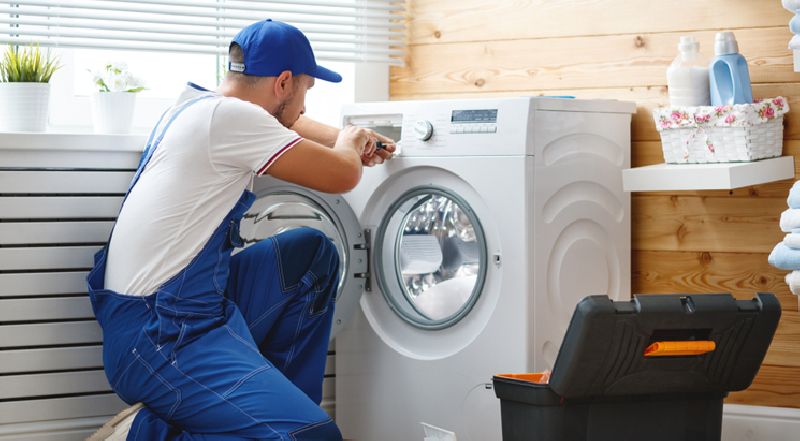I. Introduction to Washing Machines and Safety
- Overview of Washing Machine Types:
- Semi-Automatic Washing Machines (Twin Tub)
- Fully Automatic Washing Machines (Top-Load, Front-Load)
- Washer-Dryers (Combined units)
- Basic differences in operation and design.
- Fundamental Principles of Operation:
- Mechanical processes (agitation, spinning, draining).
- Electrical processes (motor operation, control signals).
- Water circulation and heating.
- Safety Precautions and Best Practices:
- Electrical safety (shock hazards, proper grounding, lockout/tagout procedures).
- Water safety (leak prevention, handling water connections).
- Mechanical safety (moving parts, handling heavy components).
- Personal Protective Equipment (PPE) – gloves, safety glasses.
- General workplace safety.
- Tools and Equipment:
- Identification and proper use of hand tools (screwdrivers, wrenches, pliers, wire cutters, strippers).
- Measuring instruments (multimeter for voltage, current, resistance, continuity).
- Specialized tools (clamping meters, specific spanners, diagnostic software if applicable for smart machines).
II. Mechanical Components and Systems
- Washing Machine Structure and Anatomy:
- Outer casing, inner drum, outer tub.
- Suspension system (springs, dampers).
- Door/Lid mechanisms (latches, interlocks).
- Agitator/Pulsator System:
- Types of agitators/pulsators.
- Function and common issues (not agitating/pulsating).
- Drum and Spin System:
- Spin motor, drive belt/direct drive.
- Bearings and seals (identifying wear, replacement).
- Spin tub issues (noise, imbalance, not spinning).
- Water Inlet and Outlet Systems:
- Inlet hoses and filters.
- Solenoid valves (cold, hot water).
- Drain pump (function, types, blockages).
- Drain hoses and standpipes.
- Transmission and Gearbox:
- Clutch mechanisms (in some top-loaders).
- Gearbox operation and common failures (noise, grinding).
III. Electrical and Electronic Components
- Basic Electricity Concepts:
- Ohm's Law, voltage, current, resistance.
- AC and DC circuits.
- Series and parallel circuits.
- Motors:
- Types of motors (induction, universal, DC brushless - BLDC for inverter models).
- Motor windings, capacitors (start/run).
- Motor troubleshooting and testing.
- Control Systems:
- Timers (mechanical and electronic).
- Pressure switches (water level control).
- Thermostats (for hot water washing).
- Door interlocks/safety switches.
- Temperature sensors (NTC thermistors).
- Control Boards (PCBs - Printed Circuit Boards):
- Understanding the function of the main control board.
- Basic troubleshooting of PCB faults (visual inspection, voltage checks).
- Understanding error codes displayed on modern washing machines.
- Wiring and Connections:
- Reading and interpreting wiring diagrams.
- Tracing electrical paths.
- Identifying loose connections, short circuits, open circuits.
IV. Installation, Maintenance, and Troubleshooting
- Washing Machine Installation:
- Site selection and leveling.
- Water supply connections (cold/hot).
- Drainage connections.
- Electrical connections and grounding.
- Initial setup and calibration.
- Routine Maintenance Procedures:
- Cleaning detergent dispenser.
- Cleaning lint filters.
- Cleaning drain pump filter.
- Checking and cleaning inlet screens.
- Cleaning drum and outer tub.
- Checking hoses for leaks or cracks.
- Preventive checks to extend appliance lifespan.
- Diagnosing Common Washing Machine Problems:
- Machine not starting/dead.
- No water filling/slow filling.
- Water not draining.
- Drum not spinning/agitating.
- Excessive noise or vibration.
- Leaking water.
- Clothes not getting clean.
- Error code diagnosis.
- Repair Techniques:
- Component testing and replacement (motors, pumps, valves, belts, capacitors, switches).
- Addressing electrical faults.
- Fixing water leaks.
- Troubleshooting electronic control boards.
- (Advanced: PCB repair at component level for specialized courses).
- Advanced Technologies (for modern machines):
- Inverter technology in motors.
- Smart washing machines (IoT integration, app control - basic understanding of how they work and common troubleshooting).
- Direct Drive technology.
V. Customer Service and Professional Practice
- Communication Skills:
- Interacting with customers, explaining issues clearly.
- Providing cost estimates and service reports.
- Handling complaints and ensuring customer satisfaction.
- Professional Ethics:
- Integrity and trustworthiness.
- Timeliness and reliability.
- Documentation:
- Maintaining service records.
- Warranty procedures (if working for a service center).
Practical Training:
A significant portion of any good washing machine repair course will involve hands-on practice. This includes:
- Disassembling and reassembling various washing machine models (top-load, front-load, semi-automatic).
- Testing individual components using a multimeter.
- Diagnosing simulated faults on live machines.
- Performing actual repairs and component replacements.
- Practicing proper installation techniques.
